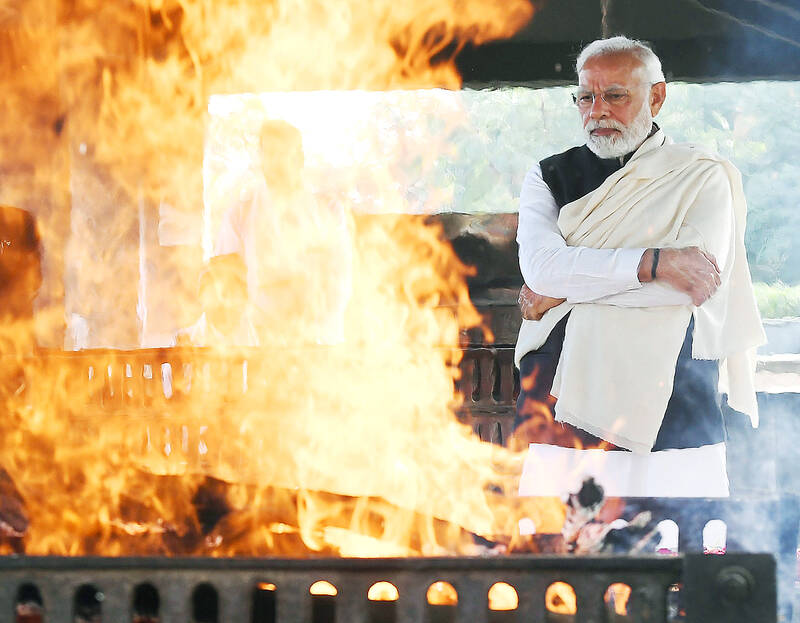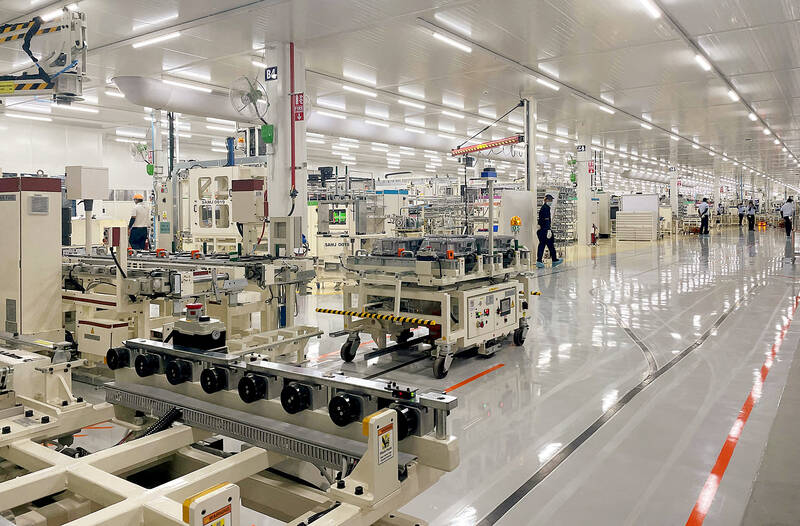On paper, India’s chances of attracting global manufacturers look rosy, but experts warn that lasting gains to improve a sluggish manufacturing sector are not within sight.
Apple Inc began assembling its latest iPhone models in the South Asian nation in a significant break from its practice of reserving much of that for Chinese factories run by its main Taiwanese assemblers, a key win for Indian Prime Minister Narendra Modi’s “Make in India” campaign.
Among India’s advantages are rising geopolitical tensions between Western nations and China, and a growing friendship with the US, Australia and Japan, which form part of the Quadrilateral Security Dialogue, a grouping of democracies to counter Beijing’s economic and military ambitions.

Photo: EPA-EFE / PIB
The country’s presidency of the G20 this year could also boost investor confidence. India is poised to hold the title of the world’s fastest-growing large economy in the next three years. Its GDP is set to become the world’s third-largest before the end of the decade.
However, experts have said that improvements to the manufacturing sector are still a ways off for India, a country of 1.4 billion people.
Modi’s “Make in India” campaign, which aims to increase exports and create jobs, has not quite panned out. Manufacturing accounts for 14 percent of the economy, a figure that has barely budged in decades, and despite India’s massive demographic dividend, unemployment remains stubbornly high.

Photo: REUTERS
Since the campaign was launched in 2014, the deadline for one of its key goals — to lift the share of manufacturing in GDP to 25 percent — has been pushed back three times, from 2020 to last year to 2025.
Amitendu Palit, an economist specializing in international trade and investment at the National University of Singapore, said decoupling from China has “not yet been pronounced.”
In other words, for any meaningful relocation of supply chains, Palit said Modi’s government would need to prove that India is a cheaper and easier place to conduct business, rather than simply relying on political or security factors to lure companies.
While financial incentives imposed under Modi offered Apple a cost-efficient path to set up shop in India, the California-based company is still making a fraction of its iPhones in the nation.
For every success, there are many companies that have quit India because of long-running challenges, such as dealing with the country’s bureaucracy, including General Motors Co, Ford Motor Co and Harley-Davidson Inc.
Friend-shoring, in which allies invest in each other, and a wider pivot away from China could benefit India — although the speed of change is far from clear.
“There is a lot of inertia,” Indian Chief Economic Advisor V. Anantha Nageswaran said.
Leaving China is not a call that companies will take lightly, as “they have invested so much in a big market,” he said.
Still, East Asian countries would eventually run into capacity constraints at some point, he said.
“So I think we need to wait for these things to play out,” Nageswaran said.

WEAKER ACTIVITY: The sharpest deterioration was seen in the electronics and optical components sector, with the production index falling 13.2 points to 44.5 Taiwan’s manufacturing sector last month contracted for a second consecutive month, with the purchasing managers’ index (PMI) slipping to 48, reflecting ongoing caution over trade uncertainties, the Chung-Hua Institution for Economic Research (CIER, 中華經濟研究院) said yesterday. The decline reflects growing caution among companies amid uncertainty surrounding US tariffs, semiconductor duties and automotive import levies, and it is also likely linked to fading front-loading activity, CIER president Lien Hsien-ming (連賢明) said. “Some clients have started shifting orders to Southeast Asian countries where tariff regimes are already clear,” Lien told a news conference. Firms across the supply chain are also lowering stock levels to mitigate

Six Taiwanese companies, including contract chipmaker Taiwan Semiconductor Manufacturing Co (TSMC, 台積電), made the 2025 Fortune Global 500 list of the world’s largest firms by revenue. In a report published by New York-based Fortune magazine on Tuesday, Hon Hai Precision Industry Co (鴻海精密), also known as Foxconn Technology Group (富士康科技集團), ranked highest among Taiwanese firms, placing 28th with revenue of US$213.69 billion. Up 60 spots from last year, TSMC rose to No. 126 with US$90.16 billion in revenue, followed by Quanta Computer Inc (廣達) at 348th, Pegatron Corp (和碩) at 461st, CPC Corp, Taiwan (台灣中油) at 494th and Wistron Corp (緯創) at

NEGOTIATIONS: Semiconductors play an outsized role in Taiwan’s industrial and economic development and are a major driver of the Taiwan-US trade imbalance With US President Donald Trump threatening to impose tariffs on semiconductors, Taiwan is expected to face a significant challenge, as information and communications technology (ICT) products account for more than 70 percent of its exports to the US, Chung-Hua Institution for Economic Research (CIER, 中華經濟研究院) president Lien Hsien-ming (連賢明) said on Friday. Compared with other countries, semiconductors play a disproportionately large role in Taiwan’s industrial and economic development, Lien said. As the sixth-largest contributor to the US trade deficit, Taiwan recorded a US$73.9 billion trade surplus with the US last year — up from US$47.8 billion in 2023 — driven by strong

ASE Technology Holding Co (ASE, 日月光投控), the world’s biggest chip assembly and testing service provider, yesterday said it would boost equipment capital expenditure by up to 16 percent for this year to cope with strong customer demand for artificial intelligence (AI) applications. Aside from AI, a growing demand for semiconductors used in the automotive and industrial sectors is to drive ASE’s capacity next year, the Kaohsiung-based company said. “We do see the disparity between AI and other general sectors, and that pretty much aligns the scenario in the first half of this year,” ASE chief operating officer Tien Wu (吳田玉) told an